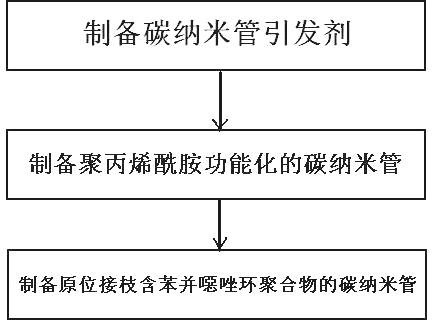Preparation method for in-situ grafting carbon nano tube containing benzoxazole ring polymer
A technology of benzoxazole rings and carbon nanotubes, applied in the field of materials, can solve problems such as the limitation of the range of applicable monomers, achieve uniform properties, wide application prospects, and maintain integrity
- Summary
- Abstract
- Description
- Claims
- Application Information
AI Technical Summary
Problems solved by technology
Method used
Image
Examples
Embodiment 1
[0034] A method for preparing carbon nanotubes grafted with polymers containing benzoxazole rings in situ, using multi-walled carbon nanotubes as the initial raw material, and 4-bromoisobutyric acid ethyl ester by Diels-Alder reaction Benzocyclobutene was grafted onto the surface of carbon nanotubes as a monomer polymerization initiator; N-(o-hydroxyphenyl) acrylamide monomer was polymerized on the surface of carbon nanotubes by atom transfer radical polymerization, and finally passed Heat treatment makes the ring closure of the polymer, and obtains carbon nanotubes grafted with polymers containing benzoxazole rings in situ; the specific steps are:
[0035] (1) Preparation of carbon nanotube initiator
[0036] Disperse 50 mg of multi-walled carbon nanotubes (manufactured by Shenzhen Nanometer Port Co., Ltd., diameter 97%) that had been calcined in air at 500 °C for 5 hours in nitrogen atmosphere in 10 g of fourteen In alkanes, after ultrasonic treatment for 30min, stirring an...
Embodiment 2
[0042] A method for preparing carbon nanotubes grafted with polymers containing benzoxazole rings in situ, using single-walled carbon nanotubes as the initial raw material, and 4-bromoethyl propionate benzene by Diels-Alder reaction And cyclobutene is grafted onto the surface of carbon nanotubes as a monomer polymerization initiator; atom transfer radical polymerization is used to initiate the polymerization of N-(o-hydroxyphenyl) methacrylamide monomer on the surface of carbon nanotubes. Finally, the polymer is ring-closed by heat treatment to obtain carbon nanotubes grafted with polymers containing benzoxazole rings in situ; the specific steps are:
[0043] (1) Preparation of carbon nanotube initiator
[0044] Disperse 50 mg of single-walled carbon nanotubes (manufactured by Shenzhen Nanometer Port Co., Ltd., diameter 90%) that had been calcined in air at 300°C for 20 hours in argon atmosphere in 20 mg of dodecyl In alkanes, after ultrasonic treatment for 30min, stir and he...
PUM
 Login to View More
Login to View More Abstract
Description
Claims
Application Information
 Login to View More
Login to View More - R&D
- Intellectual Property
- Life Sciences
- Materials
- Tech Scout
- Unparalleled Data Quality
- Higher Quality Content
- 60% Fewer Hallucinations
Browse by: Latest US Patents, China's latest patents, Technical Efficacy Thesaurus, Application Domain, Technology Topic, Popular Technical Reports.
© 2025 PatSnap. All rights reserved.Legal|Privacy policy|Modern Slavery Act Transparency Statement|Sitemap|About US| Contact US: help@patsnap.com


